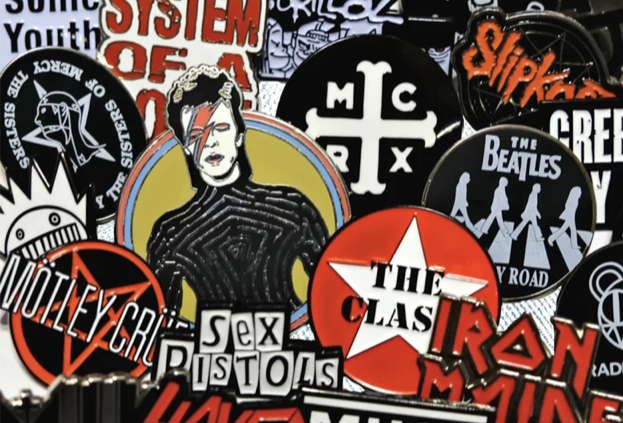A Musical Metaphor
Music as a metaphor
It’s a simple metaphor I’ve used to explain how branding works to various people who are struggling to get their heads around it. Just think about music. (I’ll admit it’s not a perfect metaphor but it does work on most levels)
Drop the R
Drop the R from Brands and you get Bands. And most people I’ve met have a favourite band / recording artist. They understand the subcultures that build around the different styles of music and how that can affect perceptions.
They understand how fans align themselves with certain bands. The bands who they feel speak to them (and for them) become incredibly precious. People form very strong attachments to the artists they feel particularly aligned with.
Bands become emblems that help to define us. And these are not connections that we hold lightly.
Fans will part with great sums of money to own limited edition releases or a particular item of memorabilia.
Just consider this list:
Kurt Cobain’s MTV Unplugged Guitar: $8,013,000.
John Lennon’s ‘Love Me Do’ Guitar: $3,206,000.
Bob Dylan’s lyrics for ‘Like a Rolling Stone’: $2,725,000
Wu-Tang Clan’s Once Upon a Time in Shaolin Album: $2,672,000
David Gilmour, of Pink Floyd’s, ‘Black Strat’ Guitar: $5,298,000
A test pressing of Elvis’ first single, ‘My Happiness’, went for auction in 2015 and eventually sold for $300,000
Memorabilia sales like these are probably well outside the pocket or even comprehension of most people. But we all witness the outpourings of grief expressed when people like Elvis, John Lennon, Kirk Cobain, Price, Michael Jackson or David Bowie died.
A fan can develop a powerful emotional connection to an artist or group that they have never met. And those associations and band emblems become tribal marks. People will go as far as to have the band logo, lyrics, signatures or faces of their idols tattooed onto them – indelibly stating their affiliation and claiming membership of a particular tribe.
This is not new. The Who or The Jam badges were emblazoned on the parkers of almost every Mod. Their Rocker rivals (who as the name suggests listened to Rock music) would adorn their leather and denim jackets with badges of the likes of Rainbow or Deep Purple or Status Quo.
Music is intrinsically linked to fashion – and both have come to identify different sub-sets of youth culture, with each generation breeding its own fashion style and music icons. Mods, Rockers, Skin-heads, Punks, New Romantics, Baggies, Emo the list goes on and on because each new generation needs something to call their own … and usually in opposition the their parents’ tribe.
Like fans and their favourite music, we can become loyal fans of particular brands. We can align and therefore to some extent, be identified and understood by the brands we align with.
Divisive alignment
The Apple, Android divide is an obvious example I could site. A Rolex serves the same basic function as a swatch. A LandRover performs the same A to B function as a SmartCar – or even a Tesla. But what each brand stand for and the associations built around the brand, that by inference to some degree transfer to their users, are very different. Brands and bands both become part of our self-image and self-identification. It’s worth noting here that we often define who we are (or want to be) by what we are not. This creates an ‘us’ and ‘them’ dynamic. And we intuitively understand what the ‘us’ tribe is, what is does, how it actsand sounds.
When we see our favourite band do something that does not seem to fit within our expectations, we experience jarring and even discomfort. It feels wrong and can upset us.
Just imagine if Iron Maiden made a transcendental, electronic music album. And this same logic extends to brands too.
Even if you don’t understand the nuance of how branding works, you can understand the surprise of meeting a Punk who then pulled out a violin and started playing classical music. (We could argue that Nigel Kennedy built his career on this very juxtaposition). So, if it came to light the senior staff at Greenpeace had investments in oil & gas their members would feel betrayed.
Some artists have tried to switch genres. Generally, it is not successful. Do you recall pop-princess Kylie Minogues’ dalliance with alternative music? (Don’t worry most people don’t).
Her fans were fans of the pure-pop Kylie. They didn’t want this new version. And this tribalism and fairly narrowly defined lanes is pretty normal for most musical artists (once established). But artists are human, and wish to explore different aspects of their personality, and express different things.
And brands can feel restrained and want to expand their offering also.
Some brands are big enough to be able to step into ‘new arenas’ with enough swagger that they can make it work.
Again, if we think of Apple’s early days as a computer manufacturer – we would probably define them at that time as being focused on tech hardware. We might not have expected their move into software and apps and no-one predicted their successful move into streamed music and TV.
I’ve never heard or read anything from any fans or music journalists who foresaw Beyoncé releasing an album that would dominate the country music charts either.
Authenticity
The trick for a successful brand extension seems to be authenticity. The move may feel odd to some but if it’s still essentially in line with what the brand or artist stands for – and is true to their general direction of travel, it can work.
The Sex Pistols (& Punk movement generally) stood for anarchy, and tearing down the established order. Interviewers knew the band members were likely to swear, be offensive and even dismissive. That was their brand – and they delivered on their promise. Their brand position was divisive, it attached those that aligned with the frustration and rigidity of social expectations and repelled those who didn’t view the world in that way.
Anti-conformity informed every aspect from how they spoke in interviews to how they dressed, how they performed and behaved (or misbehaved if you prefer!).
Beyoncés ‘Cowboy Carter’, country music album, appears to come from a genuine place – and fully aligns with her history of wanting to see black artists and people respected and valued in all fields. Even those not usually associated with them.
Like Beyoncés unexpected album, on paper, the idea of sports car manufacturer Porsche producing a 4×4 seemed questionable. Some even suggested it would undermine their brand position. But we can’t deny their success. It was an extension of the brand that people could accept because the core elements of what Porche create and stand for, could be transferred. The aspirational nature of a well-engineered sports car is not too far a stretch to a well-constructed ‘sporty’ 4×4. It’s a logical brand extension.
But could Ozzy Osbourne suddenly release an R&B record? The historic Black Sabbath fans are unlikely to follow him down that road. It’s not a stretch his brand can make. The transfer of our understanding of Ozzy and his musical heritage does not allow us to accept him as an R&B artist.
In the same vein, the public is sceptical when the big oil companies start talking about ecology and green fuels, (the reversal of my Greenpeace example). It’s too different a road and a mental reach too far.
Divisive difference
Music has its genres. Branding has categories. They different words for the same basic act of placing things into boxes so we can understand them more efficiently. We all do it.
We categorise bands in a ‘mental library’ in our heads and we even create complicated subcategories. Oasis and Blur both sat in the ‘Britpop’ section in the record store and so they fit the same category in our minds. But there was also well-documented and long-running animosity between the two giants of brit-pop Some ignored the fact the two bands were feuding – but some fans also took it to heart and they faced a binary choice. One or the other – not both.
Once categorised we know what we expect, we understand the promise that the brand/band makes and we feel secure that it will be delivered. Any movement from that expectation undermines our trust.
Brands like bands can develop and grow – but it generally needs to be a journey that includes their devotees.
Who could have imagined at the hayday of Beatlemania that the mop-topped Fab-Four would become long-haired hippies producing experimental music later in their career? The Beatles ability to change so radically was because their audience was on the same journey and experiencing the same seismic cultural shifts and political upheavals together with them.
David Bowie made a career of reinventing himself. Ziggy, Aladdin Sane, Halloween Jack, The Thin White Duke, The Soul Man. He took on these different characters in order to say and explore different aspects of himself and his art.
One could even argue that Bowie’s brand was not to have a brand.
But his brand was in fact all about that perpetual change and reinvention. Bowie fans expected it – eventually! (Although the initial demise of Ziggy Stardust took both fans and his own bandmates by surprise sum-what).
But Bowies’ characters do help us understand the idea of brand personas. Each persona is unique – and our understanding and expectations of each are different.
As I said at the start of this piece, the brands/bands metaphor is not perfect. (I can’t think of a brand that has embraced near-constant change in the same way Bowie did).
But I do know the music metaphor has helped many people who were struggling to comprehend branding to get a handle on how branding affects all aspects from behaviours to language, aesthetics and even culture.
An effective brand aligns every expression around a set of core values, just like The Sex Pistols, every action and expression flows from a central idea.







